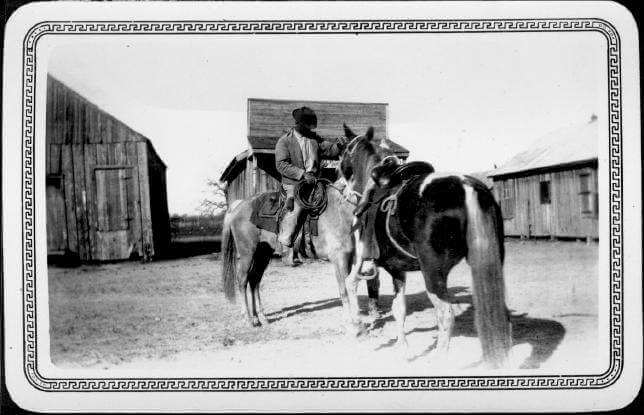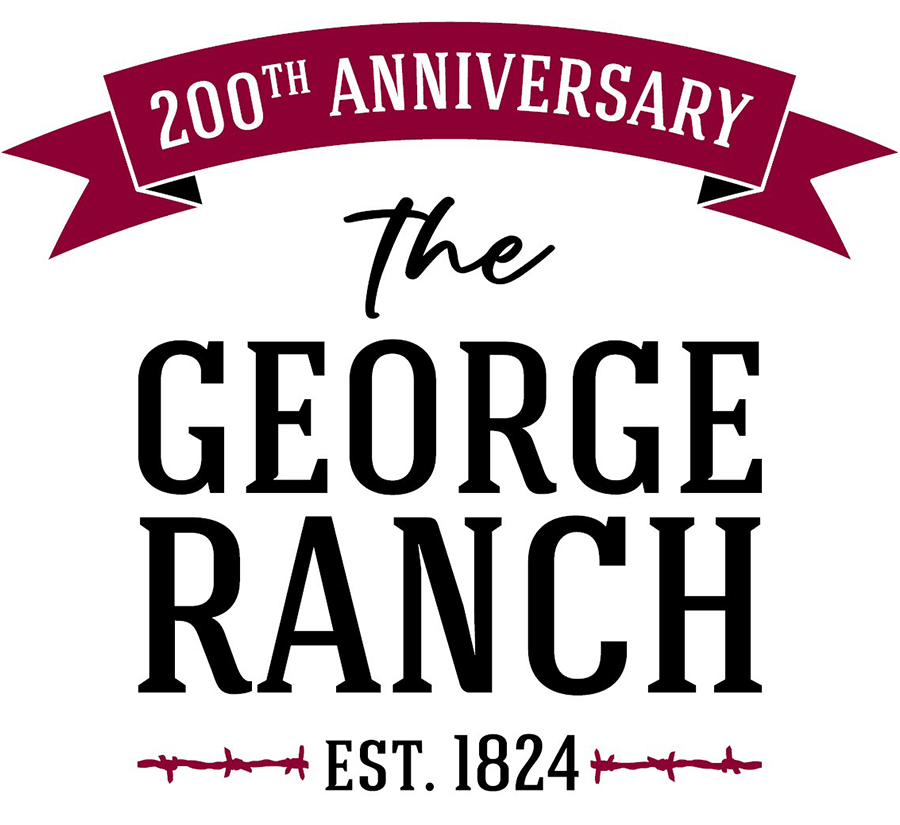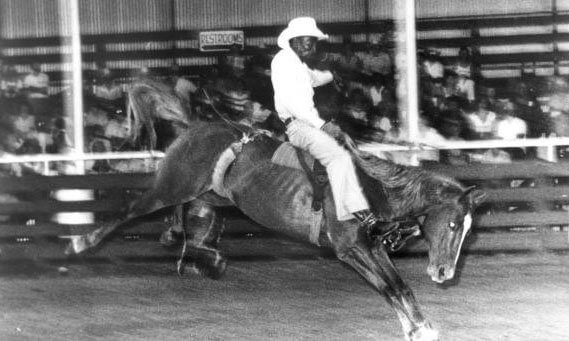A History of Diversity
Black cowboys at the George Ranch set an early tone for Fort Bend’s diverse character
By Steve Nelson
Board of Trustees, Fort Bend History Association
It’s become a well-known fact, symbolic of recent growth in our area: Fort Bend County is now the nation’s most diverse county. Our mix of residents, while perhaps surprising to outsiders with stereotypical views of Texas, is part of the unique fabric of the region we all call home.
Diversity, however, isn’t a recent phenomenon. In fact, its roots trace back to the early settlement of the county with, perhaps, an equally surprising fact of life to many — the presence and significant contributions of black cowboys to the ranching story of the area and, more specifically, the George Ranch.

This 1925 photograph of an African American cowboy on a horse was one of six photographs in an envelope addressed to Albert P. George.
The story begins with the arrival of slavery to Fort Bend County, where high cotton prices and labor shortages created a need for workers. By 1840, the county’s enslaved population was the growing Republic’s second largest. Many arrived from Cuba, Galveston and up from the mouth of the Brazos River. A majority of the early stock raisers (15 of 20) enslaved workers, with an average of 28 per ranch.
As ranches grew and productivity increased, so did the ranching skills of black workers who contributed in many vital ways, especially as cowboys. Then, on June 19, 1865, orders were issued that applied the Emancipation Proclamation to Texas’ enslaved population. The experience of one new Freedman, James Green, from a ranch in neighboring Colorado County, was typical of black cowboys of the period:
“I never knowed my age till after de war, when I’s set free de second time, and then marster gits out a big book and it shows I’s 25 year old. It shows I’s 12 when I is bought and $800 is paid for me. […] De end of dat war comes and old Pinchback (his master) says, ‘You all come to de big house in de mornin.’ He tells us we is free and he opens his book and gives us all a name and tells us whar we came from and says he pays us 40 cents a day to stay with him.”
The practice of the newly-freed persons assuming the last name of their former owners’ was typical and, as a result, has made it easier for historians to trace the roots of black cowboys and other workers.
As the freed workers began their new lives, transitions took hold — readily and smoothly in some areas and less fairly in others. The organization known as the Freedman’s Bureau and its agents worked to ensure that planters paid the freedmen, including the black cowboys, for their work on ranches. In Richmond, a bureau office was open and operating by the end of January 1866.
Early reports from one bureau agent in Houston noted that planters south and west of Houston were paying their hands and all seemed to be going well; in contrast, areas to the north and east of Houston existed in which freedmen were not getting paid and discontent and abuse prevailed.
By 1870, there were 76 cowboys in Fort Bend County and 55% of those were black cowboys (with an average age of 24). In many ways, these black cowboys advanced further and faster from slavery’s bonds than any others in the county. Their literacy rate was three times greater and their personal property ownership was 17 times that of the overall black population.
Looking back, all this creates a ready-made lens to examine and celebrate the contributions of black cowboys whose skills and names can be connected to specific ranches in our area, perhaps most notably, at the George Ranch.
One such black cowboy was Robert H. “Bob” Jones, favored slave of the Jones and Ryon families, who maintained a close association with the family and the land through the remainder of the 1800s. By 1868, just three years after his emancipation, Bob would acquire five horses and 40 head of cattle. Ten years later, he purchased 200 acres of land and by 1899 had grown his landholdings to 1,600 acres. Other names of former slaves are also reflective of leading ranching families of the times: Gibson, Scott, Jenkins, Buck and Morton.
As our area’s ranching heritage evolved, employment and skills as a cowboy continued to set the bar. Cowboy skills meant opportunity and respect. A good example can be found in the story of Tom Mills. He worked as a black cowboy and maintained a local ranch, doing “all the hirin’ and payin’ off and ever’thing” for a Boston-based land owner. Famed cattle driver Charles Goodnight’s trust in black cowboy Bose Ikard is well-documented in print and film. As Goodnight related, “He was my detective, banker, and everything else in … the wild country I was in.”
Similar relationships developed in Ford Bend County and at the George Ranch. Sam Ryon and Will Martin, for example, served as ranch managers for Polly Ryon in the last years of the 19th century.
And while the racial tensions that impacted all of the south well into the 20th century certainly did not spare our area, black cowboys encountered less prejudice and had more economic opportunity than many other African Americans.
Today, we’re proud to celebrate the skills and contributions of these cowboys and, specifically, the generations who worked for the Jones-Ryon-Davis-George families, taking on leadership roles in the ranching operations. That celebration will take place on Saturday, February 16 with the George Ranch Rodeo, honoring Fort Bend County’s black cowboy legacy. This inaugural event will spotlight brothers James and Willie Thomas, who grew up at the Ranch, riding everything they could, and eventually going on to compete in professional rodeos. For more information about the Rodeo, visit georgeranch.org/programs-events/george-ranch-rodeo.
—
Sources:
1) “Settlers, Slaves, Sharecroppers and Stockhands: A Texas Plantation-Ranch, 1824-1896” by Michael Rugeley Moore, December 2001
2) “James Green, San Antonio, Texas,” https://www.loc.gov/resource/mesn.162/?sp=92




